John Hurrell – 26 August, 2009
It is an interesting show because it allows Clifford to play with certain slippages of meaning, to calculatedly revel in ambiguities not present in some works when they were initially created (outside the electrical context) but present now.
Auckland
AC/DC: The Art of Power
Curated by Andrew Clifford
21 August - 3 October 2009
This exhibition put together by Andrew Clifford looks at the role of electricity in our lives, and its attendant eco-politics. One might at first glance make the mistake of thinking it was about light (Bill Culbert is quite a presence) but its focus is on the benefits and negative consequences of power and the national grid. It is an interesting show because it allows Clifford to play with certain slippages of meaning, to calculatedly revel in ambiguities not present in some works when they were initially created (outside the electrical context) but present now. Such are the pleasures of being a curator.
Clifford’s title is clever. It comes from the two competing systems of current transmission invented by Nikola Tesla (Alternating Current) and Thomas Edison (Direct Current) and in the middle ‘courtyard’ space is a small yellow AC/DC Billy Apple painting. It examines not electricity and corporate power but the distribution of profit from an art selling transaction, referring to the Artist’s Cut and Dealer’s Cut within a Golden Ratio. Of course here in this show that meaning alters.
Another example of contextual alteration of meaning is the large Bill Culbert work with two large, vertical, nylon fabric boxes that gradually swap illumination levels. Light is treated like water being slowly transferred backwards and forwards between two tall glasses. Culbert’s minimalist oblongs look like the Twin Towers here, especially when placed near to a striking Joanna Langford installation of skyscrapers made from recycled computer keyboards. The keys are taken out so they look like Gustonesque windowed buildings. Electricity is present in the form of twinkling LED lights spread across the city at night.
The rhythmic electrical brain pulses from a sleeping human body take on parallels with this city when a 1972 snoozing Billy Apple is filmed in a semi-conscious state. Documented as an artwork having a very light sleep, a crackling soundtrack comes from recording his alpha waves. Apple’s body and mind here are on automatic pilot, but his partner Mary Morrison has a white neon sign next door that suggests a different principle. It flashes the word ‘breathe’ eighteen times a minute, instructing the reader to inhale at the correct rate to efficiently absorb oxygen. The use of blinking commands and the conscious will, bring a black humour to this body maintenance - with its reliance on orders via electricity.
The processes of providing this country’s electrical needs are referred to in Wayne Barrar‘s two superb photographs of Huntly miners extracting coal for the nearby thermal station, Disinformation’s throbbing electromagnetic noise loop (accompanied by Barry Hale’s twitching video of power lines and insulators), and Brett Graham and Rachael Rakena’s eight circular Aniwaniwa photographs. The latter’s watery images show historic Waikato sites lost from the flooding necessary to create the Horahora Power Station and the displacement of local Maori communities like Ngati Koroki.
Joe Sheehan‘s fake battery packs have battery casings made out of greenstone, greywacke or jade, sterling silver connecting caps and Craig Potton landscape imagery as backdrops. Entitled Non-Rechargeable they are an effective, very compact protest at resource wastage; an unusual yet shrewd synthesis of different media.
Two other works in the show are Mary-Louise Browne‘s LED signs, moving texts based on her (in my view) superior granite inscribed word sequences. However these electronic noticeboards undermine her earlier method of presenting such texts where the eye is forced to move vertically to search for altered letters and extract each new word’s meaning; the LED format destroys the pleasurable eye movement associated with her original stone block format. Remarkable twelve word loops (like ‘cold bold bond bone bore born worn warn warm worm word cord’) work better as a single-word-wide vertical column than as six sets of pairs in a horizontal line.
Nicely organised, with each contributing component thoughtfully positioned, this unusual group show is well worth a walk down to Shortland Street to see.






 Advertising in this column
Advertising in this column Two Rooms presents a program of residencies and projects
Two Rooms presents a program of residencies and projects



This Discussion has 0 comments.
Comment
Participate
Register to Participate.
Sign in
Sign in to an existing account.